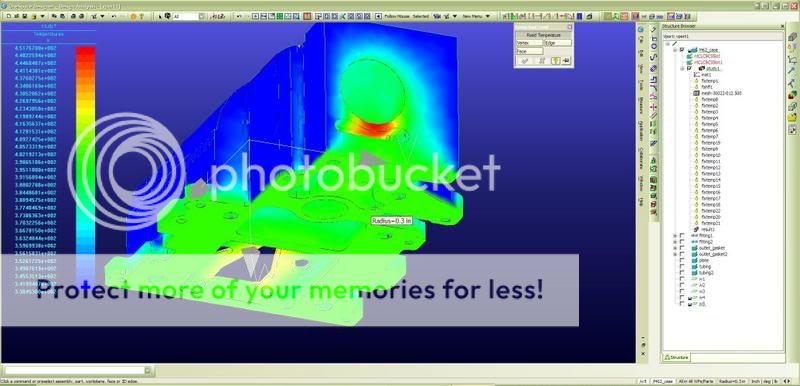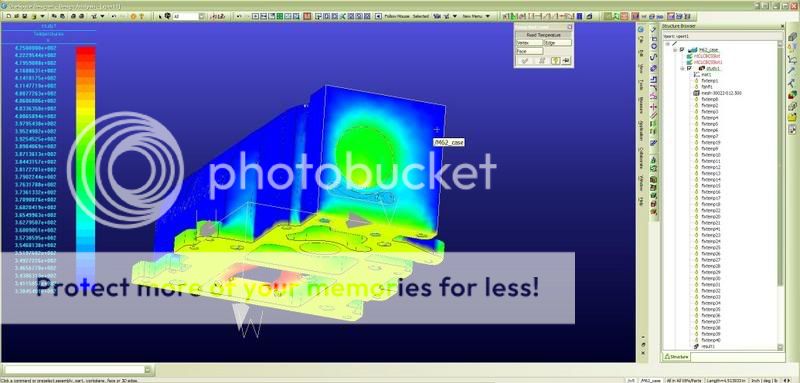Coolant plug
#22
Junior Member
Posts like a Ricer Type-R
Not any more. I have a different model loaded (work-related).
BTW, the thermal analysis I posted on the previous page of this topic only works while I'm attached to the hp network. The data for the analysis is done on a remote server in Colorado, then sent back to me via LAN. Each study takes about 5 minutes in outgoing transfer, data processing, and incoming transfer time.
There are alot of factors and variables you have to account for. When ambient temps rose, I should have increased the engine bay temps, but didn't. I really didn't need to in order to show the inlet temp improvement with coolant passages unblocked.
Bottom line is that on an L67, the hottest surface of a SC is the bottom of the inlet. And this is the one area that coolant can actually benefit you.
BTW, the thermal analysis I posted on the previous page of this topic only works while I'm attached to the hp network. The data for the analysis is done on a remote server in Colorado, then sent back to me via LAN. Each study takes about 5 minutes in outgoing transfer, data processing, and incoming transfer time.
There are alot of factors and variables you have to account for. When ambient temps rose, I should have increased the engine bay temps, but didn't. I really didn't need to in order to show the inlet temp improvement with coolant passages unblocked.
Bottom line is that on an L67, the hottest surface of a SC is the bottom of the inlet. And this is the one area that coolant can actually benefit you.
#23
Junior Member
Posts like a Ricer Type-R
Originally Posted by willwren
Let'* start with a simplified model. This is an M62 (really no different for the
purposes of the debate than an M90) under normal operating (street) conditions.
We'll ignore the track conditions for now, but we'll come back to it:

What'* the hottest surface? The INLET. Not the outlet. Why? Restriction/friction
of airflow. To be honest, this is a very simple model. It doesn't have the cooling
ports, and some of the conditions may be based on theory, rather than reality. So
we take this data as a starting point, and try to refine the model (this analysis was
done by a group of college engineering students at least 3 or 4 years ago.
Fast forward to the current state of the Zilla:

See the little temperature strips? There are 9 of them on the SC, Nosedrive, TB,
and LIM. Why? I wanted to know not only WHAT temperatures were typical in
different driving conditions, but also HOW it heats up. What'* hot first? Where
does the heat start, and how does the SC react during heatsoak? Does the
coolant actually HELP?
So then I made a model.

That was a long time ago, and for another purpose as well, but a good 3D model is
the starting point for a good thermal analysis job.
So I took everything I learned from the original thermal analysis (top image in this topic),
and everything I learned from REAL data from my own car (coolant temps, stuck-on
thermal temp strips, and IR heat analysis) in multiple conditions. Different ambient air
temps, wet weather, dry weather, street conditions, long trips, and track.
Now let'* apply all THAT to the 3D model WITHOUT coolant flow (temps are typical on
a warmed up engine after about 15 minutes of driving in ambient 60°F air, 200° LIM):

The dark blue is constrained to 150°F (338Kelvin) to represent engine bay ambient
temps, and the bottom surface is constrained to typical LIM temps. As you can see,
the BOTTOM of the inlet is the hottest surface. This is what pre-heats your incoming
air for you. Nice, huh?
Now let'* induce some coolant flow and kick up the incoming air temp a bit to REALLY
see what'* going on (85° ambient air, 180° coolant temp in the SC coolant ports, 250°F
LIM temp):

See the positive result in the inlet despite the increased IAT and LIM temps?
Coolant flow controls it.
Now to be honest, there are other factors at work here, but I think I've captured the
critical data very well in these models. On a track, with sufficient cooling, you'll be OK.
SC temps don't spike at the track until AFTER the run. But if you drive your car daily,
you need the coolant. And you can STILL cool down between runs at the track. You've
lost nothing.
Ideal solution? A seperately cooled interface plate between the SC and LIM, that routes
coolant (not engine coolant) through the plate beneath the SC, and through the SC to the
TB. Something like this:

Further incoming air temp improvements are the direct result of polishing your SC inlet.
As a point of comparison:
My Gen3 M62 inlet and TB run 15° cooler than Matt'* Gen3 M90, despite the fact that
I was moving far more air with a 2.0" pulley than his stock 3.8" pulley. This is a direct
result of polishing the rough inlet surface left over from the casting process.
This was after an extended high-throttle side-by-side run in 106°F ambient conditions.
I hope I've answered the question from this topic, at least with regards to the L67'* out
there. The data is going to come out differently for L27'* and L36'*, as the inlets won't
be as hot to begin with. But it'* something to chew on.
Long and short of it based on what I've learned on my own car and through thermal
analysis:
Normal driving conditions require the coolant to manage SC inlet temperatures
Furthermore, blocking the coolant ports is no advantage at the track if you're cooling
in the staging lanes between runs and icing the SC housing.
purposes of the debate than an M90) under normal operating (street) conditions.
We'll ignore the track conditions for now, but we'll come back to it:

What'* the hottest surface? The INLET. Not the outlet. Why? Restriction/friction
of airflow. To be honest, this is a very simple model. It doesn't have the cooling
ports, and some of the conditions may be based on theory, rather than reality. So
we take this data as a starting point, and try to refine the model (this analysis was
done by a group of college engineering students at least 3 or 4 years ago.
Fast forward to the current state of the Zilla:

See the little temperature strips? There are 9 of them on the SC, Nosedrive, TB,
and LIM. Why? I wanted to know not only WHAT temperatures were typical in
different driving conditions, but also HOW it heats up. What'* hot first? Where
does the heat start, and how does the SC react during heatsoak? Does the
coolant actually HELP?
So then I made a model.

That was a long time ago, and for another purpose as well, but a good 3D model is
the starting point for a good thermal analysis job.
So I took everything I learned from the original thermal analysis (top image in this topic),
and everything I learned from REAL data from my own car (coolant temps, stuck-on
thermal temp strips, and IR heat analysis) in multiple conditions. Different ambient air
temps, wet weather, dry weather, street conditions, long trips, and track.
Now let'* apply all THAT to the 3D model WITHOUT coolant flow (temps are typical on
a warmed up engine after about 15 minutes of driving in ambient 60°F air, 200° LIM):

The dark blue is constrained to 150°F (338Kelvin) to represent engine bay ambient
temps, and the bottom surface is constrained to typical LIM temps. As you can see,
the BOTTOM of the inlet is the hottest surface. This is what pre-heats your incoming
air for you. Nice, huh?
Now let'* induce some coolant flow and kick up the incoming air temp a bit to REALLY
see what'* going on (85° ambient air, 180° coolant temp in the SC coolant ports, 250°F
LIM temp):

See the positive result in the inlet despite the increased IAT and LIM temps?
Coolant flow controls it.
Now to be honest, there are other factors at work here, but I think I've captured the
critical data very well in these models. On a track, with sufficient cooling, you'll be OK.
SC temps don't spike at the track until AFTER the run. But if you drive your car daily,
you need the coolant. And you can STILL cool down between runs at the track. You've
lost nothing.
Ideal solution? A seperately cooled interface plate between the SC and LIM, that routes
coolant (not engine coolant) through the plate beneath the SC, and through the SC to the
TB. Something like this:
Further incoming air temp improvements are the direct result of polishing your SC inlet.
As a point of comparison:
My Gen3 M62 inlet and TB run 15° cooler than Matt'* Gen3 M90, despite the fact that
I was moving far more air with a 2.0" pulley than his stock 3.8" pulley. This is a direct
result of polishing the rough inlet surface left over from the casting process.
This was after an extended high-throttle side-by-side run in 106°F ambient conditions.
I hope I've answered the question from this topic, at least with regards to the L67'* out
there. The data is going to come out differently for L27'* and L36'*, as the inlets won't
be as hot to begin with. But it'* something to chew on.
Long and short of it based on what I've learned on my own car and through thermal
analysis:
Normal driving conditions require the coolant to manage SC inlet temperatures
Furthermore, blocking the coolant ports is no advantage at the track if you're cooling
in the staging lanes between runs and icing the SC housing.
No more comments on this?
#25
Junior Member
Posts like a Ricer Type-R
It'* to prevent icing of the throttle shaft in cold weather by my understanding.
BTW, notice I haven't even taken into account the heat effects of teh EGR and PCV.
And your air WILL be hot. Not only is it in contact with very hot surface, it'* also being compressed into the inlet.
BTW, notice I haven't even taken into account the heat effects of teh EGR and PCV.
And your air WILL be hot. Not only is it in contact with very hot surface, it'* also being compressed into the inlet.
#27
Junior Member
Posts like a Ricer Type-R
Dirthead, it'* to prevent icing the THROTTLE PLATE on cold starts. 
Dirthead, heat is the enemy, right? Causes KR, prevents dropping pulley diameters,
right?
Polishing the rough inlet is the #1 proven way between my car and a Series 2 car on this Forum to drop a common pulley diameter with no other changes. Why? Heat. Why on earth would you want to allow your inlet to heatsoak by plugging off the coolant flow?
I for one, believe the thermal analysis. If I had your deadhead system, I'd machine the adapter to allow the flow. Your everyday driving experience will benefit from it, and it won't detract from your track experience.

Dirthead, heat is the enemy, right? Causes KR, prevents dropping pulley diameters,
right?
Polishing the rough inlet is the #1 proven way between my car and a Series 2 car on this Forum to drop a common pulley diameter with no other changes. Why? Heat. Why on earth would you want to allow your inlet to heatsoak by plugging off the coolant flow?
I for one, believe the thermal analysis. If I had your deadhead system, I'd machine the adapter to allow the flow. Your everyday driving experience will benefit from it, and it won't detract from your track experience.
#29
Junior Member
Posts like a Ricer Type-R
Edit above. I got bored with fishing. 
The thermal analysis has proven the benefit of the coolant flow (as has my own car being a test subject with nine temperature strips on the top end for the last 8 months). And there'* no negative effect at the track if you cool down between runs.
The thermal analysis has proven the benefit of the coolant flow (as has my own car being a test subject with nine temperature strips on the top end for the last 8 months). And there'* no negative effect at the track if you cool down between runs.
#30
Senior Member
Posts like a Turbo
Join Date: Aug 2005
Location: Grand Rapids,MI
Posts: 226
Likes: 0
Received 0 Likes
on
0 Posts

You don't account for a lot of things in your "thermal analysis". You didn't even keep the boundary conditions the same from test to test but you insist that your analysis is conclusive....makes me laugh.....literally.



